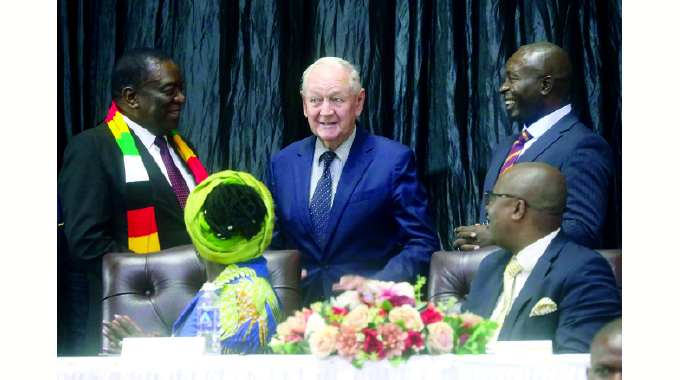Government launches new digital route permits for public service buses

Freeman Razemba
Senior Reporter
Government has launched a new digital route permit for public service buses which has counterfeit deterrence measures readable by any mobile phone.
The measures will now be easy for any traffic law enforcement agents to verify and validate the authenticity of the permit
In a statement, Transport and Infrastructural Development Minister Felix Mhona confirmed the developments.
“Pursuant to the objectives of the National Development Strategy 1, which envisages the modernisation of our economy using ICT and digital technologies, the Ministry of Transport and Infrastructural Development wishes to advise the public of the launch of the digital Route Permits for public service buses.A digital Route Permit is issued in terms of Section 12 of the Road Motor Transportation Act [Chapter 13:15].
“The permit, which has enhanced security features and counterfeit deterrence measures, has a digitally signed barcode which is readable by any mobile phone. In that regard, it is now easy for traffic law enforcement agents to verify and validate the authenticity of this Permit.
“Further, the new ICT system for processing this Route Permit is fully integrated with the Central Vehicle Registry to validate vehicle licensing and registration details. This system is also integrated with insurance companies to validate statutory third-party motor insurance and passenger liability cover,” he said.
The minister said this will enhance the ease of doing business for bus operators, who will enjoy the convenience of reduced waiting times when they apply for the new Route Permit issued at our Road Motor Transportation Offices situated in all the provincial centres across the country.
“From a transport planning perspective, this new system will enhance our capacity to monitor the supply of buses on all routes with a view to avoid route over-saturation – thereby regulating competition in the passenger transport sector,” Minister Mhona said.
He said the Road Motor Transportation Act [Chapter 13:15] provides for the licensing, registration and regulation of passenger and freight transport operators. In addition, the Public Service Vehicle Regulations prescribed in Statutory Instrument 134 of 1998 provides for the standards that are essential for the safe operation of public service vehicles.
“Therefore, the strategic objective of Road Motor Transportation is to improve road safety and security.In line with National Development Strategy 1 (NDS 1), improved road transport services are critical in improving accessibility, and facilitating both domestic, regional, and international trade through easing the movement of goods and people,” said Minister Mhona.
He said decentralization and Devolution In the Second Republic, RMT has established offices in all the country’s 10 provincial centres.he said this is in support of Government’s policy of decentralisation and devolution meant to achieve improved access to services by the public.
“Likewise, RMT is therefore involved in the transport development planning at provincial and local levels,” he said.
Minister Mhona said Computerisation of Operator’s Licence Application Process In the same gesture of increasing the use of ICT and digital technologies in the transport sector, the automation of RMT and other road service departments under the Ministry of Transport and Infrastructural Development supports the e-Governance policy.
“RMT launched an automated operator’s licence platform that is integrated to the Central Vehicle Registry (CVR) public service drivers’ database and the Vehicle Inspectorate Department’s (VID) garage inspection systems.When one applies for an operator’s licence, the system validates the list of drivers in the CVR database as well as the garage report in the VID system.
“In addition, automation of the operator’s licence module enables the decentralisation of the issuance of these licences at provincial sites. The introduction of this system has improved service turnaround times and at the same time eliminated duplications and impressively reduced inaccuracies associated with manual systems,” he said.
He said to date, 7 584 operator’s licences, with a total vehicle count of 15 990, have been issued through the system.
He said the operator’s licence system provides the following functions: A real time electronic database of operators per operator type Integration with CVR and VID to validate drivers’ qualifications and garage inspection reports.
“National Daily transaction detailed reports Segregation of system roles (data capturing, verification, approval, and issuance of licenses).
“RMT is now issuing digital Route Permits for public service buses. A digital Route Permit is issued in terms of Section 12 of the RMT Act [Chapter 13:15] to passenger transport operators who service various intracity and intercity routes across the country. This digital Route Permit has enhanced security features and as a counterfeit deterrence measure, this Permit has a digitally signed barcode which is readable by any mobile phone. This makes it easier for traffic law enforcement agents to verify and validate the authenticity of this Permit.
“The new ICT system for processing this Route Permit is fully integrated with CVR to validate vehicle licensing and registration details. This system is also integrated with insurance companies to validate statutory third-party motor insurance and passenger liability cover. This will enhance the ease of doing business for bus operators who will enjoy the convenience of reduced waiting times when they apply for the new Route Permit issued at our RMT Offices situated in all the provincial centres across the country,” he said.
He said from a transport planning perspective, this new system will enhance RMT’s capacity to monitor the supply of buses on all routes with a view to regulate competition in the passenger transport sector.
Minister Mhonan said noting the challenges in the movement of people, the reduction in the national bus fleet, rapid urbanization, increasing urban congestion and rural transportation, government introduced duty exemption on the importation of new buses into the country.
He said this was meant to address transport challenges and increase the use of mass transport systems particularly in urban areas.
“Some operators have taken up the offer and the national bus fleet has significantly increased.
“Since August 2022, bus operators have imported more than 300 brand new buses. The duty-free policy is meant to capacitate bus operators to complement the services offered by the Zimbabwe United Passenger Company (ZUPCO).
“Under the framework of Bilateral Road Transport Agreements signed between Zimbabwe and its neighbours there are provisions for transport operators to be issued with Cross border permits. This Cross-border permit has extraterritorial jurisdiction which allows the operators to freely transverse the SADC region. This is meant to facilitate trade and ensure a smooth and seamless flow of traffic across borders,” he said.
Minister Mhona said the Digital Cross-border permits will be launched during the second quarter of 2023.









Comments